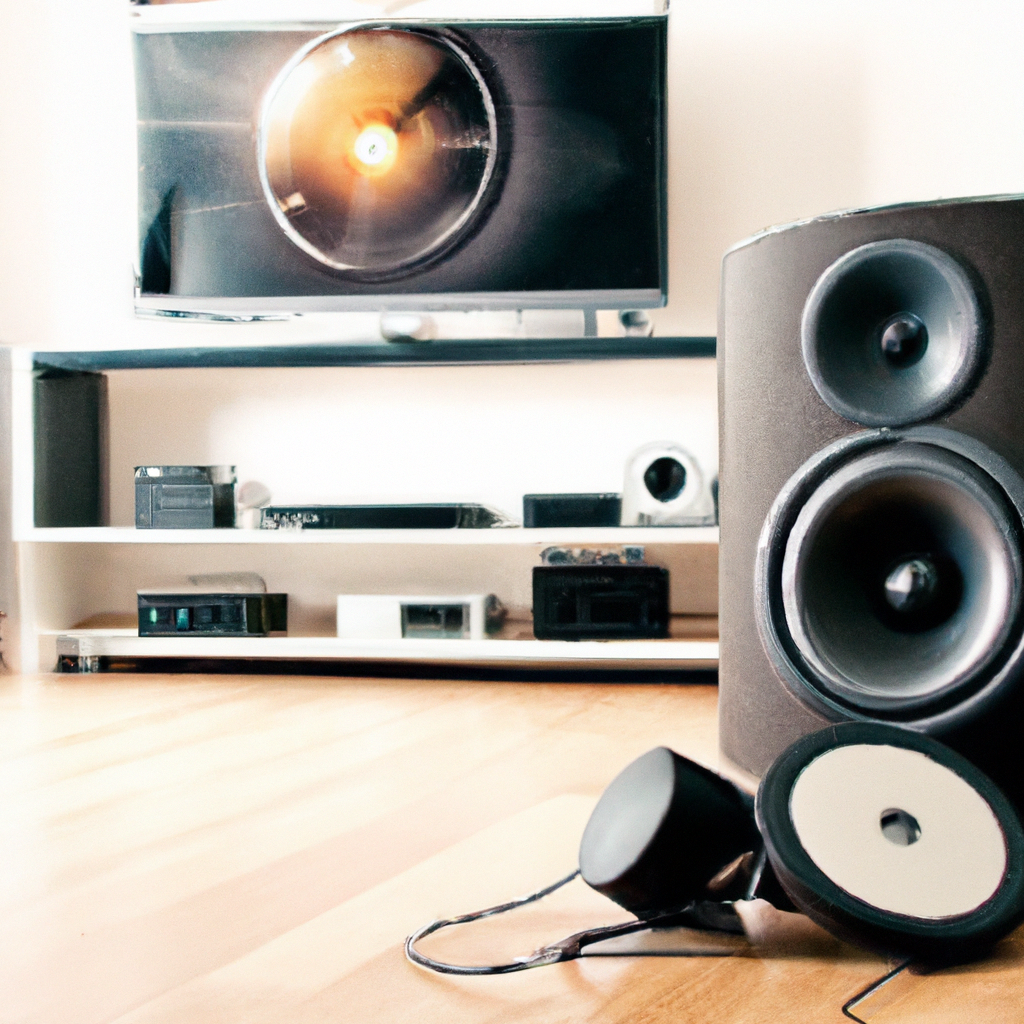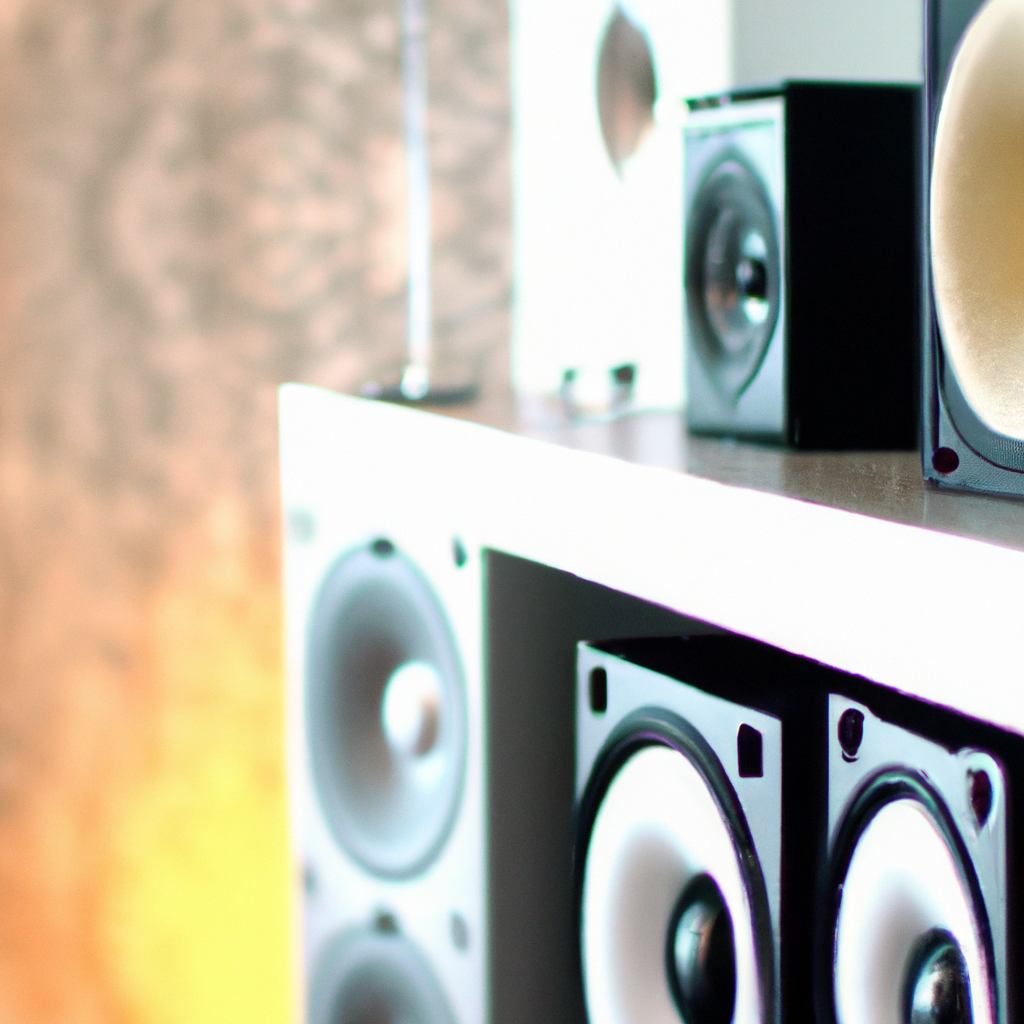If you’re someone who loves to have music playing in every corner of your home, then you’ve probably wondered how you can set up multi-room audio. Whether it’s for a party or just for your own personal enjoyment, having synchronized music playing in multiple rooms can create a truly immersive experience. In this article, we’ll explore various ways in which you can achieve this and transform your home into a haven of harmonious melodies. From wireless speakers to specialized audio systems, we’ll cover all the options available so you can easily make your dream of multi-room audio a reality.
Assess Your Needs and Budget
When considering setting up a multi-room audio system in your home, it’s important to assess your needs and budget. This will help you determine the best approach for your specific requirements.

Determine the number of rooms you want to include in your multi-room audio setup
Start by identifying the rooms in your home where you would like to have audio capabilities. This could include the living room, bedrooms, kitchen, home office, or any other areas where you frequently spend time. Take note of the number of rooms you want to include, as this will impact the type of system you choose.
Consider the type of audio sources you want to use
Think about the different audio sources you would like to utilize in your multi-room setup. This could include streaming services such as Spotify or Apple Music, your personal music library, television and home theater integration, or even Bluetooth connectivity for playing audio directly from your devices. Understanding your desired audio sources will help you select a system that is compatible and meets your needs.
Determine your budget for the multi-room audio system
Setting a budget is an important step as it will guide your decision-making process. Multi-room audio systems can vary greatly in price, depending on factors such as the number of rooms, audio quality, and additional features. Consider how much you are willing to invest in your system and make sure to keep that in mind as you explore different options. This will help you narrow down your choices and ensure you are selecting a system within your financial means.
Choose the Right Audio System
Once you have assessed your needs and budget, it’s time to choose the right audio system for your multi-room setup. This decision will have a significant impact on your overall audio experience, so it’s important to carefully consider your options.
Wired or Wireless System
One of the first decisions you’ll need to make is whether to go with a wired or wireless audio system. Each has its own advantages and considerations. Wired systems typically offer higher audio quality and reliability, but require running cables throughout your home. Wireless systems, on the other hand, offer more flexibility and ease of installation, but may be subject to interference or quality limitations.
Dedicated Multi-room Audio System vs. Smart Speaker Setup
Another important consideration is whether to opt for a dedicated multi-room audio system or a smart speaker setup. A dedicated system is specifically designed for multi-room audio, offering more advanced features and customization options. Smart speakers, on the other hand, provide a simpler and more affordable solution, with the added benefit of voice control through virtual assistants like Amazon Alexa or Google Assistant.
Consider the Audio Quality and Features
When choosing an audio system, pay close attention to the audio quality it offers. Look for systems that support high-resolution audio if you value pristine sound reproduction. Additionally, consider the features that are important to you, such as the ability to create zones or groups of rooms, adjustable volume levels, and equalization settings. Make sure the system you choose aligns with your audio preferences.
Compatibility with your Existing Devices
It’s crucial to ensure that the audio system you select is compatible with your existing devices. Check whether your preferred streaming services are supported, whether your devices have the necessary connectivity options (such as Bluetooth or Wi-Fi), and whether the system integrates with other smart home devices you may already have. Compatibility will provide a seamless and hassle-free experience, allowing you to enjoy your multi-room audio setup to its fullest potential.
Select Audio Sources
With your audio system selected, it’s time to choose the specific audio sources you want to utilize in your multi-room setup. This will enable you to enjoy a wide range of audio content across your home.
Streaming Services and Music Libraries
Streaming services have become increasingly popular for music lovers, providing access to vast catalogs of songs. Consider which streaming service you prefer, whether it’s Spotify, Apple Music, Tidal, or another platform, and ensure that your chosen audio system supports it. Additionally, if you have a personal music library stored on your device or computer, make sure the system can easily integrate and play your local files.
Bluetooth Connectivity
Bluetooth connectivity offers a convenient way to play audio from your mobile devices directly to your multi-room setup. This allows you to stream not only music but also podcasts, audiobooks, and any other audio content you have saved on your phone or tablet. Check if your chosen audio system has Bluetooth capabilities and easily pair your devices for seamless wireless streaming.
Television and Home Theater Integration
If you plan to incorporate your television and home theater setup into your multi-room audio system, compatibility is key. Look for systems that can integrate with your TV, allowing you to stream audio from movies, shows, and games throughout your home. This creates a more immersive and cinematic experience, giving you the ability to enjoy surround sound in multiple rooms.

Auxiliary Input Options
In addition to streaming services and Bluetooth, you may have other audio sources you want to connect to your multi-room system. Consider any auxiliary devices you want to integrate, such as CD players, turntables, or even gaming consoles. Ensure that your chosen system has the necessary inputs and compatibility to connect and enjoy audio from these devices.
Determine Speaker Placement
Speaker placement plays a crucial role in achieving optimal sound quality and coverage in each room of your multi-room audio setup. Carefully consider the layout and acoustics of each room to make informed decisions.
Consider the Size and Acoustics of Each Room
The size and acoustics of each room will impact the placement and type of speakers you choose. Larger rooms may require more powerful speakers or additional subwoofers for better coverage and bass response. Additionally, rooms with high ceilings or hard surfaces may benefit from speakers that have adjustable directional tweeters to control sound reflections.
Ceiling or Wall-Mounted Speakers
Ceiling or wall-mounted speakers are a popular choice for incorporating audio into your multi-room setup. These speakers can be discreetly installed, saving space and providing a clean aesthetic. Consider whether in-ceiling or in-wall speakers are the best option for your rooms, and ensure that the placement provides an optimal listening experience for everyone in the space.
Bookshelf or Floorstanding Speakers
If you prefer more flexibility in speaker placement or if your room layout does not lend itself well to in-ceiling or in-wall speakers, bookshelf or floorstanding speakers could be a great alternative. These types of speakers can be placed on shelves, stands, or furniture, allowing you to position them in the most suitable locations for optimal sound coverage. Consider the size and style of the speakers to ensure they blend well with your room’s decor.
Placement for Surround Sound Experience
For rooms where you want to create a surround sound experience, proper speaker placement is crucial. A typical surround sound setup includes front left and right speakers, a center speaker, and rear speakers. Consider the specific guidelines provided by the audio system manufacturer to position the speakers correctly for immersive audio during movies, gaming, or other surround sound content.
Set Up a Multi-room Audio Network
Setting up a reliable and seamless multi-room audio network is essential to ensure smooth audio streaming throughout your home. Consider the following factors when configuring your network.

Wi-Fi or Ethernet Connection
The first step in setting up your multi-room audio network is to decide between a Wi-Fi or Ethernet connection. Wi-Fi offers more convenience and flexibility, allowing you to connect wirelessly to your audio system. Ethernet, on the other hand, provides a more stable and consistent connection for uninterrupted audio streaming. Assess your needs and evaluate the capabilities of your audio system to determine the best connection option for your setup.
Ensure a Reliable Network for Seamless Audio Streaming
To ensure smooth audio streaming, it’s essential to have a reliable network. Make sure your Wi-Fi router is capable of handling multiple devices and maintaining a strong signal throughout your home. Consider using a mesh Wi-Fi system or range extenders to eliminate dead zones and provide a consistent connection to all the rooms in your multi-room setup. This will prevent audio dropouts and interruptions while enjoying your favorite music.
Configure Network Settings and Passwords
As you set up your audio network, it’s crucial to configure the necessary network settings and passwords for security and privacy. Change the default network name (SSID) and password to protect your network from unauthorized access. Additionally, consider creating a separate guest network if you frequently have visitors who may want to connect to your audio system.
Syncing Audio Across Multiple Rooms
Syncing audio across multiple rooms ensures that you can enjoy the same music or audio content seamlessly throughout your home. Check if your chosen audio system has built-in synchronization capabilities that allow for accurate timing and audio alignment across different speakers. This will create a cohesive and immersive audio experience, even when moving between rooms.
Explore Different Control Options
Controlling your multi-room audio system should be intuitive and user-friendly. Explore the various control options available to personalize your audio experience.
Dedicated Audio Control Panels
Some multi-room audio systems offer dedicated audio control panels that can be installed on the walls of each room. These panels provide a centralized and tactile way to control the audio playback, volume levels, and other settings. Consider whether having physical control panels aligns with your preferences and if they provide the convenience and ease of use you desire.

Smartphone and Tablet Apps
Most audio systems offer smartphone and tablet apps that allow you to control and manage your multi-room setup from the palm of your hand. These apps provide a user-friendly interface, giving you access to all the features and settings of your audio system. Consider whether having the flexibility to control your audio system from anywhere in your home is important to you, and ensure that the app is available for your device’s operating system.
Voice Control Assistants
The rise of voice control assistants such as Amazon Alexa, Google Assistant, or Apple Siri has revolutionized home automation, including multi-room audio systems. Consider choosing an audio system that integrates with one of these voice control platforms, allowing you to control your audio playback, volume, and other functions using simple voice commands. This hands-free control option can enhance the overall user experience, especially when your hands are occupied or if you prefer a more effortless control method.
Universal Remote Control Integration
For those who already have a universal remote control for their home theater setup, look for a multi-room audio system that can integrate with it. This allows you to consolidate control of your audio and video devices onto a single remote, providing a seamless and unified experience. Consider whether this integration is important to you and if it aligns with your desired level of convenience and simplicity.
Test and Configure Your System
Once your multi-room audio system is set up, take the time to test and configure it to ensure optimal performance and customization to suit your preferences.
Pairing and Syncing Speakers
If your audio system includes wireless speakers, ensure that they are properly paired and synced with the central hub or main audio source. Follow the manufacturer’s instructions to set up each speaker, and confirm that all speakers are working together as intended. Double-check the synchronization to avoid any audio delays or inconsistencies when playing music across multiple rooms.
Adjusting Volume Levels and Audio Settings
Take the opportunity to adjust the volume levels and audio settings based on your preferences and room acoustics. Each room may have different audio characteristics, so fine-tuning the settings for each space ensures an optimized listening experience. Experiment with EQ settings, speaker balance, and sound modes to find the perfect audio setup for your multi-room system.

Creating Zones and Grouping Rooms
If your multi-room audio system supports zone or room grouping, consider setting up different zones based on your needs. This allows you to play different audio content in specific rooms or synchronize audio across multiple zones. By creating zones, you have more control and flexibility over which rooms are playing audio and what content they are playing. Take the time to configure this feature according to your preferences, making it easier to customize your audio experience.
Troubleshooting and Fine-tuning
During the initial setup and testing phase, be prepared to troubleshoot and fine-tune your system. If you encounter any issues, refer to the user manual or the manufacturer’s support resources for troubleshooting steps. It’s common to experience minor issues, such as connectivity problems or audio dropouts, but most can be resolved with simple adjustments. Take the time to fine-tune your system to ensure it meets your expectations in terms of audio quality and performance.
Expand and Upgrade Your Multi-room Audio System
As you enjoy your multi-room audio system, you may find the desire to expand and upgrade it over time. Consider these options to enhance and future-proof your setup.
Adding More Rooms and Speakers
If you find that your original multi-room setup doesn’t cover all the areas you desire, consider expanding it by adding more rooms and speakers. Make sure your audio system has the capacity to accommodate additional speakers, and that it’s scalable to meet your growing needs. Whether you want to extend audio capabilities to a home gym, outdoor patio, or even a dedicated home theater, adding more rooms and speakers allows you to enjoy music throughout your entire home.
Integrating with Smart Home Devices
As smart home technology continues to evolve, consider integrating your multi-room audio system with other smart devices in your home. This could include connecting it to your smart lighting system, thermostat, or even voice-controlled virtual assistants. Integrating with smart home devices not only enhances the overall automation and convenience of your home but also provides opportunities for seamless control and integration of various systems.
Upgrading to High-Resolution Audio
If you’re an audiophile or someone who values the highest quality sound reproduction, consider upgrading your multi-room audio system to support high-resolution audio. High-resolution audio offers greater detail and nuance, providing a more immersive and lifelike listening experience. Confirm that your audio system is capable of playing high-resolution audio files and that your network can handle the larger file sizes to fully enjoy the benefits of high-fidelity sound.
Future-Proofing with Modular Systems
To future-proof your multi-room audio system, consider choosing a modular system that allows for easy upgrades and expansion. Modular systems offer flexibility and the ability to add new features or technologies as they become available. This ensures that your audio system can adapt to advancements in audio technology and meet your changing needs without requiring a complete overhaul. Look for systems that offer modular components or upgradability to maximize the lifespan and versatility of your setup.
Consider Professional Installation
While setting up a multi-room audio system is achievable as a do-it-yourself project, it’s worth considering the benefits of professional installation to ensure the best possible audio experience.
DIY vs. Professional Installation
If you have a good understanding of audio technology and feel comfortable with the setup process, a DIY installation may be suitable for you. DIY installations provide a sense of accomplishment and allow you to have full control over the system configuration. However, if you are unfamiliar with audio systems or prefer a hassle-free setup, professional installation is an excellent option.
Consulting with Audio Experts
Professional audio experts have the knowledge and experience to recommend and configure the best multi-room audio system for your specific needs. They can assess your home’s acoustics, guide you in choosing the right speakers, and ensure optimal speaker placement. Consulting with audio experts helps you make informed decisions and avoid potential pitfalls, ensuring a smooth and efficient setup.
Benefits of Professional Installation
Professional installation offers numerous benefits, including peace of mind and guaranteed performance. Experienced installers can handle all aspects of the installation, including running cables, configuring network settings, and conducting thorough testing to ensure everything is functioning correctly. Additionally, professional installers can provide personalized demonstrations and training, allowing you to fully understand and utilize your multi-room audio system to its fullest potential.
Ensuring Proper Wiring and Configuration
A critical aspect of a successful multi-room audio installation is ensuring proper wiring and configuration. Professional installers have the expertise to run cables discreetly and efficiently, optimizing both the audio quality and aesthetics of your setup. They can also configure the system to suit your preferences and troubleshoot any issues that may arise during the installation process. With professional installation, you can trust that your system is set up correctly and designed to deliver the best audio experience possible.
Troubleshooting and Maintenance
Like any complex technology, multi-room audio systems may encounter issues or require routine maintenance. Understanding how to troubleshoot and maintain your system will ensure long-term satisfaction and reliability.
Common Issues and Solutions
Common issues that may arise with multi-room audio systems include audio dropouts, connectivity problems, or difficulty syncing speakers. If you experience any issues, refer to the user manual or contact the manufacturer’s support for specific troubleshooting steps. It’s important to follow these steps carefully, as they often resolve common issues and prevent the need for further intervention.
Firmware and Software Updates
To ensure optimal performance and access to the latest features, regularly check for firmware and software updates for your multi-room audio system. Manufacturers often release updates that address bugs, improve stability, or introduce new functionalities. Make it a habit to periodically check for updates and follow the instructions provided by the manufacturer to keep your system up to date.
Regular Maintenance and Cleaning
Proper maintenance and cleaning of your multi-room audio system can extend its lifespan and ensure consistent performance. Dust and debris can accumulate on speakers and components, affecting sound quality and potentially causing malfunctions. Regularly clean your speakers and audio equipment according to the manufacturer’s recommendations. Additionally, check the cables and connections periodically to ensure they are secure and in good condition.
Seeking Technical Support
If you encounter persistent issues or require more advanced technical support, don’t hesitate to reach out to the manufacturer or authorized service centers. They have technicians who specialize in multi-room audio systems and can provide expert assistance and guidance. Be prepared to provide detailed information about the issue you’re experiencing, as this will help the support team diagnose and resolve the problem more efficiently.
In conclusion, setting up a multi-room audio system in your home can provide an immersive and enjoyable audio experience. By assessing your needs and budget, choosing the right audio system, selecting appropriate audio sources, determining optimal speaker placement, setting up a reliable network, exploring control options, and testing and configuring your system, you can create a personalized and seamless audio setup. Additionally, consider expanding and upgrading your system, considering professional installation, and familiarizing yourself with troubleshooting and maintenance procedures. With careful planning and execution, you can transform your home into a haven of high-quality music and audio entertainment.










